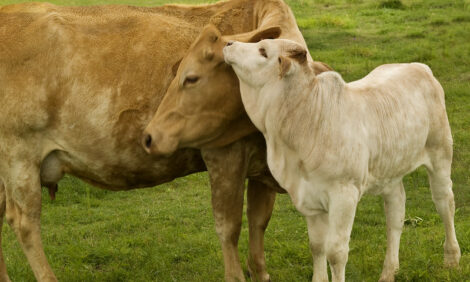



High Corn Prices Push Feeder Cattle Prices Down
US - The recent run up in corn prices will probably translate into lower feeder cattle prices, according to Tim Petry, North Dakota State University Extension livestock economist.Normally at this time of the year producers do see a dip in feeder prices as the calves hit the market after being taken off pasture, Mr Petry said, but this year the seasonal price retreat is going to be due more to the upward swing in corn prices.
“The corn market is going berserk more than we thought, and it’s going to have an impact on all feeder livestock, for sure,” Mr Petry said. “And it’s unfortunate timing too, because the calf marketing season in North Dakota has been put on hold due to the good forage conditions. There’s just no hurry to wean calves.
“Normally by the middle of October we start seeing some really heavy runs of feeder calves at the markets, but because of the good pasture conditions, they are just starting to trickle in.”
Mr Petry called the increasing corn prices a black cloud over the feeder business right now, but then quickly added that every black cloud has a silver lining.
“One silver lining that I see is, we do have a lot of forages in the state - a lot of hay and good corn silage for those who put up silage this year,” he said. “And as corn prices go up, feedlots want to buy heavier calves and pay a little more for that heavier weight, so that they don’t have to put it on. If we can put on weight in North Dakota cheaper than a heavily corn-based feedlot ration, it might pay us to do so.”
Mr Petry is encouraging cow/calf operators to do a little pencil pushing and determine if they can use the plentiful roughage supplies they have to put on some additional weight with cheaper feed costs.
“Adding weight to calves at less than a feedlot pound of gain cost is going to pay off,” he said. “Every year we have to pencil out if backgrounding works, but the higher corn prices are even another reason producers should sit down and consider doing some backgrounding, even if it’s only for a one hundred pound gain or so.”
Mr Petry said producers will have to be patient and wait and see what’s going to happen to corn prices.
“It isn’t positive for feeder cattle prices this fall, but I still think feeder cattle are going to average 10 to 15 per cent better than they did the last two years, when they were really in the doldrums in the fall,” he said. “Overall, it may not be as bad as it looks right now.”
Mr Petry also thinks there will be an increase in the number of heifers going into the backgrounding pens in the next few months and decisions made later on as to whether they will then be pulled out for additions to a cow/calf operation or continue their journey to the feedlot.
“That’s the nice thing about heifers, they can go two ways on them,” he noted. “When spring gets here they can sell them to a feedlot or use them for herd rebuilding. I think there is building interest in increasing herd numbers, and this corn price situation is just another thing that is putting it on hold.”
The cattle industry will likely see more demand for their product now that the US economy is starting to pick up and our export numbers are increasing, according to Mr Petry. Both of these factors have been down in the last few years, mainly due to circumstances that the livestock industry wasn’t able to control - mainly the worldwide recession that also impacted the United States, and the BSE scare that caused many of the nations to cut back on beef imports from the US.
“Now, with an improvement in the global economy and an increased demand for protein from the developing nations, that’s all positive,” he said. “This demand should spark prices enough that we will see build-up in numbers in the cattle industry and we will get back to a more normal 10-year cycle in the cattle industry.”
In looking at other parts of the cattle industry, Mr Petry said fed cattle prices could possibly reach new record highs in the next couple of months, but was quick to add that those prices are needed to cover the rapidly increasing input costs. Also, cow prices this year will set an all time high.
As far as other segments of the meat production industry, Mr Petry said hog prices are at near record prices, with the latest Hogs and Pigs Report indicating a two per cent downturn in the size of the breeding herd. The poultry industry is ramping up as well, since they have favorable prices compared to last year.


